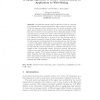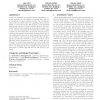1215 search results - page 205 / 243 » Dimensions of machine learning in design |
ICASSP
2011
IEEE
13 years 1 months ago
2011
IEEE
Gradient boosting is a flexible machine learning technique that produces accurate predictions by combining many weak learners. In this work, we investigate its use in two applica...
GECCO
2007
Springer
14 years 4 months ago
2007
Springer
Connectivity patterns in biological brains exhibit many repeating motifs. This repetition mirrors inherent geometric regularities in the physical world. For example, stimuli that ...
AUSAI
2007
Springer
14 years 4 months ago
2007
Springer
Dimensional reduction may be effective in order to compress data without loss of essential information. Also, it may be useful in order to smooth data and reduce random noise. The...
KDD
2004
ACM
14 years 10 months ago
2004
ACM
In order to effectively use machine learning algorithms, e.g., neural networks, for the analysis of survival data, the correct treatment of censored data is crucial. The concordan...
DSMML
2004
Springer
14 years 1 months ago
2004
Springer
The arithmetic-coding-based communication system, Dasher, can be driven by a one-dimensional continuous signal. A belt-mounted breath-mouse, delivering a signal related to lung vol...


